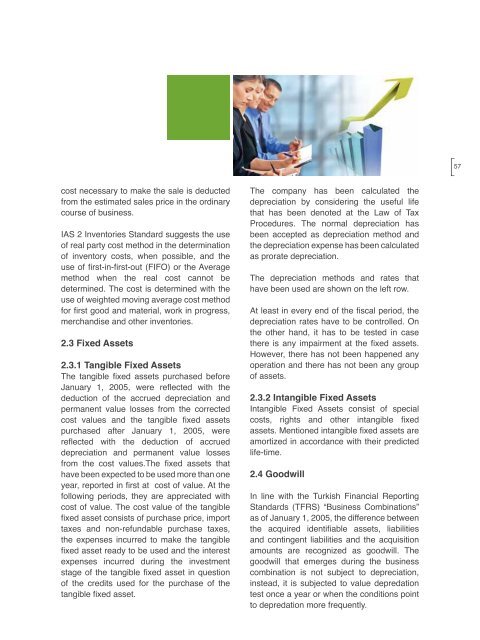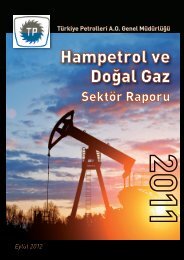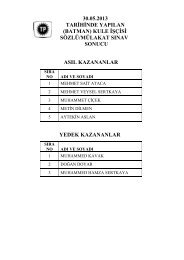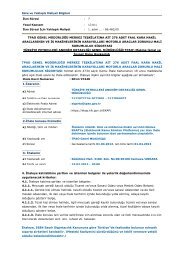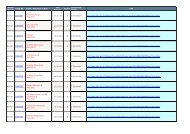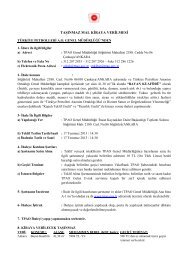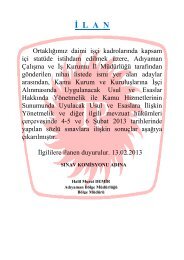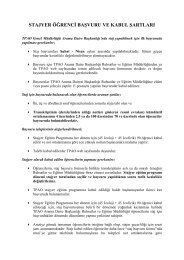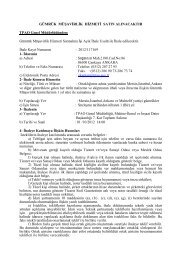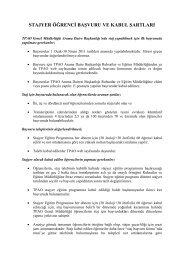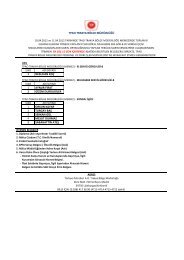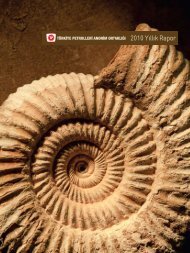5 - TPAO
5 - TPAO
5 - TPAO
You also want an ePaper? Increase the reach of your titles
YUMPU automatically turns print PDFs into web optimized ePapers that Google loves.
57<br />
cost necessary to make the sale is deducted<br />
from the estimated sales price in the ordinary<br />
course of business.<br />
IAS 2 Inventories Standard suggests the use<br />
of real party cost method in the determination<br />
of inventory costs, when possible, and the<br />
use of first-in-first-out (FIFO) or the Average<br />
method when the real cost cannot be<br />
determined. The cost is determined with the<br />
use of weighted moving average cost method<br />
for first good and material, work in progress,<br />
merchandise and other inventories.<br />
2.3 Fixed Assets<br />
2.3.1 Tangible Fixed Assets<br />
The tangible fixed assets purchased before<br />
January 1, 2005, were reflected with the<br />
deduction of the accrued depreciation and<br />
permanent value losses from the corrected<br />
cost values and the tangible fixed assets<br />
purchased after January 1, 2005, were<br />
reflected with the deduction of accrued<br />
depreciation and permanent value losses<br />
from the cost values.The fixed assets that<br />
have been expected to be used more than one<br />
year, reported in first at cost of value. At the<br />
following periods, they are appreciated with<br />
cost of value. The cost value of the tangible<br />
fixed asset consists of purchase price, import<br />
taxes and non-refundable purchase taxes,<br />
the expenses incurred to make the tangible<br />
fixed asset ready to be used and the interest<br />
expenses incurred during the investment<br />
stage of the tangible fixed asset in question<br />
of the credits used for the purchase of the<br />
tangible fixed asset.<br />
The company has been calculated the<br />
depreciation by considering the useful life<br />
that has been denoted at the Law of Tax<br />
Procedures. The normal depreciation has<br />
been accepted as depreciation method and<br />
the depreciation expense has been calculated<br />
as prorate depreciation.<br />
The depreciation methods and rates that<br />
have been used are shown on the left row.<br />
At least in every end of the fiscal period, the<br />
depreciation rates have to be controlled. On<br />
the other hand, it has to be tested in case<br />
there is any impairment at the fixed assets.<br />
However, there has not been happened any<br />
operation and there has not been any group<br />
of assets.<br />
2.3.2 Intangible Fixed Assets<br />
Intangible Fixed Assets consist of special<br />
costs, rights and other intangible fixed<br />
assets. Mentioned intangible fixed assets are<br />
amortized in accordance with their predicted<br />
life-time.<br />
2.4 Goodwill<br />
In line with the Turkish Financial Reporting<br />
Standards (TFRS) “Business Combinations”<br />
as of January 1, 2005, the difference between<br />
the acquired identifiable assets, liabilities<br />
and contingent liabilities and the acquisition<br />
amounts are recognized as goodwill. The<br />
goodwill that emerges during the business<br />
combination is not subject to depreciation,<br />
instead, it is subjected to value depredation<br />
test once a year or when the conditions point<br />
to depredation more frequently.


